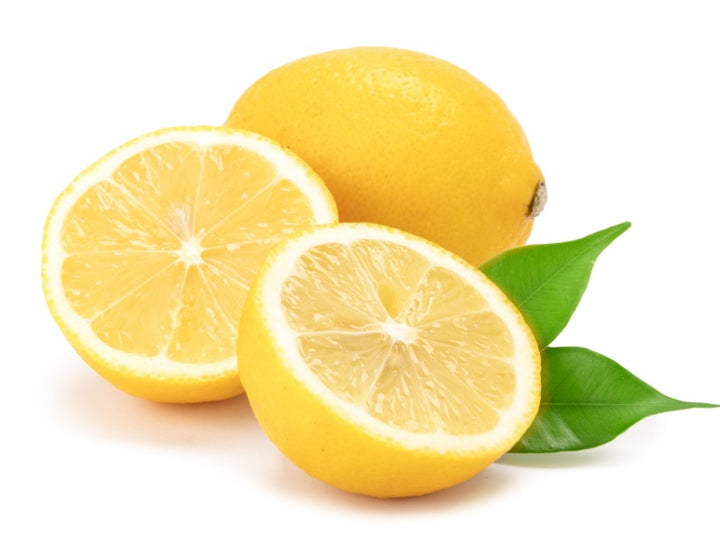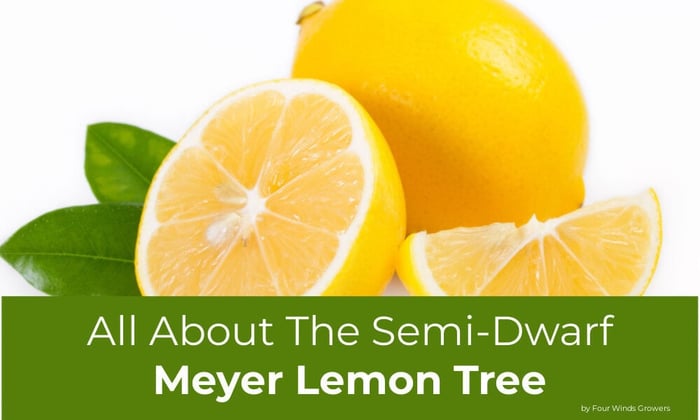The Meyer lemon tree (Citrus × meyeri) is a popular citrus fruit tree known for its sweet and fragrant lemons. It is believed to be a cross between a lemon and a mandarin. The Meyer Lemon was named after Frank N. Meyer, an agricultural explorer who brought back a sample of the tree from China in the early 20th century. The fruit gained popularity because of its sweeter flavor compared to traditional lemons and its adaptability to different climates and conditions. The thin skin and flesh can vary in color from deep yellow to orange when fully ripe and the fruit is rounder and smaller than typical lemons. The zest and juice are highly prized by chefs and home cooks for their unique flavor in cooking, baking, and making beverages.
Grafted semi-dwarf Meyer lemon trees are more compact than standard lemon trees. They can reach a height of about 8-12 feet when grown in the ground, and smaller in containers. The leaves are glossy and green, and the tree produces fragrant white and purple flowers. Meyer lemon trees thrive in subtropical to temperate climates and can be grown in containers or in the ground in US Zones 9 - 11. If you live in a colder climate, you can grow them in containers and bring them indoors during the colder months.
Here are some care tips for growing Meyer lemon trees at home:
Lemon trees require 6-8 hours of full sun daily. Plant your tree in well-draining soil so that the fragile roots do not stay wet for extended periods. Overwatering or overly saturated soil is the #1 cause of yellow and/or dropped leaves. Water the tree deeply when the top inch or two of soil becomes dry.
Planting in the ground: For in-ground planting, plant the tree in a prepared area about 3x the diameter of the pot, and as deep as possible. That soil should be well-draining and loose, allowing for root growth. Plant your tree at the same depth as the pot, keeping the crown of the roots just above the soil line. Water thoroughly after planting.
In the early spring, prune the tree to maintain a desirable shape and remove dead or diseased branches. Watch out for common citrus pests like aphids, scale insects, and whiteflies. Regularly inspect the tree for signs of pests or diseases, and treat your tree if necessary.
When it comes to fertilizing, feed the tree with a balanced fertilizer monthly during the spring and summer and early fall months. These are considered the growing months. Apply it according to the manufacturer's instructions. A weaker dilution of fertilizer is better than too much or too strong of a dose.
If you're growing Meyer lemon trees in colder climates, make sure to protect them from frost. Move potted trees indoors and add a supplemental grow light and maybe even some added humidity. Keep your tree in a sunny window away from drafts and/or heating vents.
Meyer lemon trees are a rewarding addition to home gardens or indoor spaces, providing you with delicious fruit and sweet smelling blossoms.
$65.00
--OVERVIEW-- Available in 36"-48" Premium Size! Our Best Selling Citrus Tree! The Meyer Lemon tree is a California favorite Grows very well in containers The fruit is very juicy and less tart than Eureka Lemon or Lisbon Lemon. The gourmet Meyer lemon… read moreImproved Meyer Semi-Dwarf Lemon Tree

See our Semi-Dwarf Meyer Lemon Trees
Read more about Bringing Your Tree Indoors for the Winter
Read more about Growing Citrus Trees Indoors




